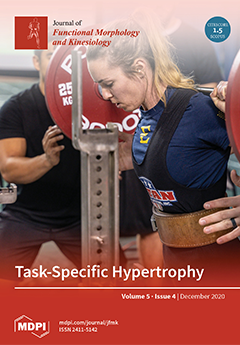This case study examined changes in body composition, resting metabolic rate (RMR), aerobic capacity, and daily physical activity in a patient who had ulcerative colitis and underwent ileal pouch-anal anastomosis (IPAA) surgery. Body composition, RMR, and peak oxygen consumption (VO
2peak) were
[...] Read more.
This case study examined changes in body composition, resting metabolic rate (RMR), aerobic capacity, and daily physical activity in a patient who had ulcerative colitis and underwent ileal pouch-anal anastomosis (IPAA) surgery. Body composition, RMR, and peak oxygen consumption (VO
2peak) were assessed prior to surgery and four, eight, and 16 weeks after IPAA surgery. Daily physical activity data were extracted from a wrist-worn activity tracker preoperatively and 16 months postoperatively. At baseline, total body mass was 95.3 kg; body fat, 11.6%; lean body mass, 81.1 kg; RMR, 2416 kcal/d; and VO
2peak, 42.7 mL/kg/min. All values decreased from baseline at four weeks postoperatively, body mass was 85.2 kg (−10.5%); body fat, 10.9% (−6.0%); lean body mass, 73.1 kg (−9.9%); RMR 2210 kcal/d (−8.5%) and VO
2peak, 25.5 mL/kg/min (−40.3%). At 16 weeks postoperatively, most parameters were near their baseline levels (within 1–7%), exceptions were VO
2peak, which was 20.4% below baseline, and RMR, which increased to nearly 20% above baseline. After the patient had IPAA surgery, his total and lean body masses, RMR, and aerobic capacity were markedly decreased. Daily physical activity decreased postoperatively and likely contributed to the decreased aerobic capacity, which may take longer to recover compared to body composition and RMR parameters.
Full article






